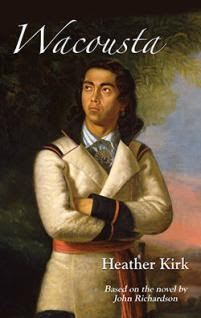| ________________
CM . . .
. Volume XXIV Number 4. . . September 29, 2017
excerpt:
The novel Wacousta, by John Richardson (1796-1852), was first published in 1832. Set in 1764, just after the British took Quebec, it concerns a white man who, masquerading as a First Nations warrior, is encouraging Chief Pontiac to make war on the British garrisons at Forts Detroit and Michilimackinac because of his personal lust for vengeance against Colonel Charles de Haldimar, Fort Detroit's commander. Physically huge and strong, Wacousta is a monster of a different sort than the one in Mary Shelley's Frankenstein (1818), and yet both novels are melodramatic and gothic. Wacousta is unique in being set in the Canadian wilderness. Canadian-born Richardson, of British and First Nations ancestry, was a soldier, novelist and journalist. These days, Wacousta, his major work, is seldom read except by scholars, mostly because his lavish, ornate, Latinate style is difficult for 21st century readers. Author Heather Kirk has rewritten Wacousta to make it more readable. "I removed the boring Latinate verbiage and left the exciting story line," Kirk says. She based her novel on the full authoritative version of the novel published by Carleton University Press in 1990. Some critics take exception to a writer rewriting another author's creation. In University of Toronto Quarterly, (Vol.76, No.1, 2007), Dennis Duffy asserted that the original Wacousta extracted "popular imaginative appeal from a Canadian temporal and spatial location"... That is why it remains of interest, not because it delivers a story of universal appeal that only needs a few of its rhetorical rough spots - its 'wordy, abstract prose style' - smoothed over to turn it into Oprah material." Others, however, like Kirk's version. Her Wacousta, which features a striking cover (the 1838 painting, "The Last of the Hurons", by Antoine Plamondon) is being given, currently, by the Canadian Historical Society as an award book for young people, and it is sold at several historic sites. Those who object to Kirk cutting and rewriting Richardson's novel should bear in mind that authors have been adapting other writers' work for centuries. One thinks of Charles and Mary Lamb's Tales from Shakespeare, published in 1807, a retelling of 20 Shakespeare plays for young people. Like Kirk, they tried to retain the essence of the original while simplifying it. In addition to verbiage, has anything been lost in Kirk's adaptation? The passages quoted at the beginning of this review show the merits and problems of each version. In Kirk's rewrite, Valletort makes an abrupt jump from a hypothetical occasion for sympathy to an expression of romantic interest in Lieutenant de Haldimar's sister. Richardson's wordy passage shows a nuance omitted by Kirk - that Valletort was attracted to his friend Charles' physical appearance. Kirk also chose not to develop the segment about the First Nations heroine in love with an English officer, who is in love with an Englishwoman who happens to be his cousin. An exploration of racial attitudes of the era would probably have been controversial, yet enlightening. When a novel is made into a movie, it is often changed substantially from the original. Changing a 19th century gothic melodrama into a 21st century young adult novel is almost as big a change as making it into another medium. Perhaps Kirk should have thrown caution to the winds and departed even more drastically from Richardson's work. Instead of continuing with Richardson's multiple viewpoints, she could have told the story from one major character's point of view, thus simplifying the story and getting up close and personal. Using first names for the many characters who have the same surname and eliminating some of the bloodbaths might have helped the novel. At first, the violence is dramatic, but eventually it gets tiresome. Changing the novel's structure would have had some advantages too. It takes too long to get to the intriguing part of the story. Not until halfway through do we see Wacousta and Captain Charles de Haldimar "on stage", and two of the four women characters (Madeline and Clara de Haldimar) appear in scenes only in the last half of the novel. Fuller development of the sections involving the women characters (the de Haldimar girl cousins; Ellen Halloway and Oucanasta) would have given young women readers some characters with whom they might identify. Kirk tries to retain the flavour of eighteenth century thought patterns and modes of expression, but occasionally a 21st century term creeps in; for instance, where Lieutenant de Haldimar's mood of anxiety and melancholy is described as "depression". Elsewhere, someone is described as "highly motivated", a phrase no one used in 1764 or 1832. In compressing a long novel into a short one, Kirk often tries to pack too much information into sentences and paragraphs. Compressing leads to summary and reportage, not showing; for example:
Although Kirk might have written a more satisfactory novel if she had boldly transformed Wacousta, she deserves applause for undertaking her project. Novels from bygone eras may no longer succeed as literature, yet at the same time convey much of historical interest. It is praiseworthy to want to make an archaic work reader-friendly and educate young readers about our past. Recommended. Ruth Latta's latest book is the young adult historical novel, Grace and the Secret Vault (Ottawa, Baico, 2017 info@baico.ca).
To comment
on this title or this review, send mail to cm@umanitoba.ca.
This Creative Commons license allows you to download the review and share it with others as long
as you credit the CM Association. You cannot change the review in any way or use it commercially. Commercial use is available through a contract with the CM Association. This Creative Commons license allows publishers whose works are being reviewed to download and share said CM reviews provided you credit the CM Association.
Next Review | Table of Contents For This Issue - September 29, 2017 |
